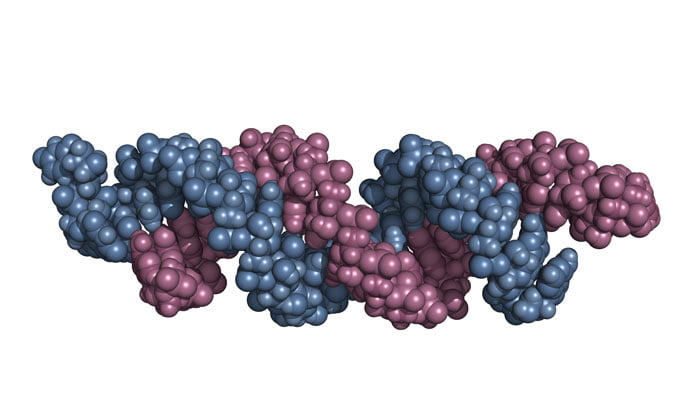Scientists uncover the secret to how piRNAs defend the genome
Posted: 2 February 2018 | Drug Target Review | No comments yet
Researchers from the University of Chicago have uncovered the mechanism by which small RNA molecules (piRNAs) locate and silence foreign invading genes, whilst avoiding ‘self’ genes.


Thousands of short RNA molecules with diverse genetic sequences serve as security guards to identify and silence attempts to invade the genome, such as DNA inserted by viruses or parasitic elements known as transposons. These diverse, small RNA molecules, known as Piwi-interacting RNAs (piRNAs) are produced by various animals, from insects and worms to mammals like mice and humans.
In a new study published today, researchers from the University of Chicago describe how piRNAs locate foreign genetic sequences in order to silence them. They also show how endogenous or ‘self’ genes that belong in the genome identify themselves to avoid this same scrutiny.
“Nearly every animal has these small RNAs, and they use them as a guide to look for target sequences and silence them,” said Heng-Chi Lee, PhD, Assistant Professor of molecular genetics and cell biology at UChicago and senior author of the study.
“Until now though, it was rather mysterious what their function was, and why there are so many with such diverse genetic sequences.”
RNA acts as messengers to carry out instructions coded in DNA to produce proteins that perform essential functions in the body. In the new study, Lee and his colleagues studied piRNAs produced by cells in the reproductive system of the nematode worm, C. elegans, a classic model organism studied by scientists to understand basic biological processes.
Piwi-interacting RNAs are a type of small RNA that associate with what’s known as Argonaute machinery in cells that search for target RNAs and shut them down. RNA is built with the same chains of nucleotides that mirror sequences of DNA, denoted with the same familiar A, C, G, U lettering. Some small RNAs need to match the target sequence exactly to identify them, like a security guard looking for a specific person. Other small RNAs can flag genes with a partial match, like identifying a suspect that fits a general profile.
Questioning the vast numbers of piRNAs
Scientists haven’t been sure exactly how piRNAs find their targets, partly owing to their sheer numbers. The nematode that Lee studies, for example, has more than 15,000 piRNAs with different nucleotide sequences. This led him to question why they appear in such numbers and what purpose they serve.
“It’s really unclear why the cells have to produce so many piRNAs. They are so diverse that it’s hard to know which one recognises which target RNAs. The relationship is too complex,” Lee said.
When Piwis recognise their target, they recruit a set of even smaller secondary RNAs corresponding to the sequence to be present at the target site, thus marking it for attention. With this knowledge, Lee and his team created a synthetic piRNA with a sequence that didn’t exist in the worm and tracked where it created its marker. By then examining the different sequences the synthetic piRNA marked, they could work backwards to figure out its logic for finding a match.
Best possible match
The study observed that piRNAs need a fairly close match to a portion of the sequence, but they can tolerate a few mismatches in the remaining portion. It also appears that there are so many unpaired Piwis in the worms because they have a toolbox of many possible sequence combinations to identify foreign RNAs and turn them off.
Avoiding false positives
To test whether piRNAs wrongly identify endogenous genes, Lee and his colleagues engineered more piRNAs that could recognise several well-known genes that belong in the nematode genome. They discovered that this set of piRNAs didn’t silence or affect the function of the endogenous genes at all, meaning they were somehow resistant.
The researchers also found that many endogenous genes had additional repeating sections of A and T nucleotides that mark them as “self” and not foreign. This licensing signal serves as a credential to identify the gene: a passport to prove the piRNA system that it belongs.
“We demonstrated that the endogenous genes are able to resist the piRNA system with a licensing system, and that’s really cool,” Lee said. “All they have to do is mark themselves with a ‘self’ signal.”
The study sheds light on a basic mechanism that can affect fertility in animals. Previous research has shown that if Piwi genes develop mutations, the piRNA system can malfunction. Then, if viruses or transposons inject foreign DNA elements into the germ line, or reproductive cells that produce eggs and sperm, piRNAs aren’t there to detect and silence them. These undetected changes can lead to infertility and other issues in the reproductive system.
The study was supported by the Ministry of Science and Technology, Taiwan, as well as the National Institutes of Health.
Related topics
Genetic analysis, Genomics, RNAs
Related conditions
infertility
Related organisations
Ministry of Science and Technology - Taiwan, National Institutes of Health (NIH), University of Chicago
Related people
Heng-Chi Lee



